
K11 Art Mall in Shanghai features art installations and more to attract customers for more than just the shopping. (Flickr/SimonQ錫濛譙)
China's massive shopping mall building spree and spate of new department store openings mean that competition is tougher than ever for domestic shopping centers attracting discerning Chinese luxury consumers—especially as they increasingly head abroad and shop online in search of lower prices. As a result, malls are doing everything they can to bring customers through the doors, including hosting art exhibits with Monet paintings and featuring live pigs and mermaids.
During a panel at the recent China Luxury Summit, organized by the China Luxury Industry Association (CLIA), on June 19-20, 2014 in Shanghai, Wall Street Journal China Wealth and Luxury Editor Wei Gu moderated a discussion on what the future holds for shopping centers in China amidst a current oversupply with Folli Follie China Country Director Aris Maroulis and Value Retail China CEO Mark Israel. Look below for excerpts from the discussion, which covers topics including the state of outlet malls versus shopping malls in China, what malls are doing to stand out from the crowd, and how department stores can adapt to China’s competitive retail market.
Wei Gu (WG): What is the difference between being a landlord in Europe versus here?#
Aris Maroulis (AM):#
In Europe, landlords are much more involved with brands. In department stores, they do their own merchandising. In China, there aren’t national champion landlords yet. Once those exist, there will be more merging and sophistication.
WG: Is it an advantage for brands that there aren#
’t national champions?#
AM:#
It can go either way if your brand is powerful enough. We want more sophisticated landlords.
Mark Israel (MI):#
To echo what Aris is saying, the gap is shrinking rapidly. The mistake people sometimes make is to underestimate the speed of change in China. The more interesting question for all of us is what is going to happen next. The first topic is very often e-commerce; what it’s going to do and what share it is going to take as opposed to brick and mortar because I think the counterweight to brick and mortar is e-commerce. So the landlord needs to respond to that by increasing the value of the offering and the partnership. Otherwise, brands will just walk away because it’s very expensive to open a store.
What is interesting is to see whether the department store will get a second life here. If we look at more mature markets, department stores that have consolidated are struggling to show profits. I think there is room here for department stores with a curated view that stand for something. But the notion of a department store as just a collection of things you want to buy has very little future here.
WG: There is an oversupply of malls that creates a challenge. What are some of the things to make it more interesting for consumers?#
AM:#
You see more differentiated shopping malls. Iapm, for example, is like a Guggenheim. So we start to see landlords making a lot more differentiation and putting thought process behind it. But there is overcapacity. From a brand standpoint, it’s a bit of pressure because landlords need to fill a shopping mall, but brands tend to be more cautious than before. You don’t want to be first or last to sign. So when is the right time? Everyone is kind of playing a guessing game. There is more negotiation going on.
From our side, it is an opportunity to use it to negotiate rents, renegotiate if necessary, negotiate down. The market force is working. I think some shopping malls have been bad investments and those will have a problem. But I think the future is definitely more shopping malls than department stores and the channels will improve. Now everyone is building them but we have to go through a cycle.

K11 Art Mall in Shanghai enlists live baby pigs to predict World Cup results as a way to lure customers into the shopping center. (Weibo/K11)
WG: Why more shopping malls than department stores?#
AM:#
We’re talking about experience. Shopping malls can offer something 24 hours a day—more food and beverage, more design, for the whole family. It’s not just shopping; it’s the overall experience. In China, some, very few, department stores, are curating. It’s still early and there is still no successful model doing that. It will take time and department stores need to change before they can do that.
MI:#
One of the challenges of experiential retail is the retail side of it. We can create more experiences but if ultimately they don’t lead to more shopping, then it doesn’t work. For example, in Europe, there might be three to four food and beverage posts, but in Suzhou we have 15. As a landlord, you don’ take money on food and beverage, so unless it does something to help your retail, it is a loss leader. From our point of view, we’re looking to capture someone’s day that is four to five hours minimum or eight to 10 hours maximum. Part of taking care of the customer is to feed them well. For us, the food and beverage increases dwell time and dwell time increases spending.
I live in Kerry Center in Jing’an. If you observe, the food and beverage is packed. The retail is starting to do better but it’s still lagging. It has yet to translate to shopping. If you look at K11, there are great things with art. The Monet has been a profit maker. But the question is whether that will be integrated into the shopping experience. That’s what I think people haven’t cracked yet—-the integration of the shopping experience and retail. Not just here, but globally.
WG: What about the role of art in malls?#
MI:#
We have three levels of art: static art, digital interactive art, and performance art. Those are set. They engage and educate people. If art forms an emotional connection with a customer, then they want to come back for it. If it is just beautiful decoration they put up somewhere, then it has no emotional value.
AM:#
Art is a buzzword; everyone is trying to do something about art. Landlords have to find a way that works, not just copy.
WG: Why the slow development of outlets in Shanghai?#
AM:#
There are many outlets, but most would not be appropriate for brands like ours. We would like to find more outlets, but we need to find appropriate ones.
WG: Have you worked with online outlets like VIPshop?#
AM:#
We do, but it’s more flash sales, lower on the tier.
WG: How do outlets serve as an educational platform for luxury shoppers?#
MI:#
Sixty-five out of a hundred people who buy in outlets will go on to buy full price. With four to four and a half million visitors in the first year, many will be introduced to a brand for the first time. A lot of brands welcome the exposure. When we think about more elite brands, they don’t want to be as open. For these brands, many consumers will walk by the door but at our outlet; they may walk in. For many people who haven’t experienced a brand, two things happen: one, they will realize, “maybe the brand is for me,” [and] two, they are at the early stages of earning and having experienced the brand younger, they are more likely to continue buying. Another issue is education, which is always hard—we have a trained sales team for every store that knows what a brand stands for. If you do a good job telling your story, they will want to seek you out after they go home or when they travel globally.
AM:#
It’s been hard to do brand education through outlets. There’s also a learning curve for a brand about how to educate a consumer via outlets. It is a different consumer and even if it is the same consumer, they behave differently.
WG: What does the expansion of outlets tell us about the state of Chinese retail? Is it about a slowdown or is it showing the market is going more towards the middle class?#
MI:#
It means both those things. It is a natural element of the maturation of a market. We all know once goods are here inside of China, it’s prohibitive to send them elsewhere. It’s a necessary feature. Whether you view it as a necessary evil or positive part of distribution, it depends on what your options are for distribution or your view of outlets. It’s really the only market in the world that has room for outlets. The U.S. and Europe are both pretty fully growth. No other market is large enough to support a robust outlet industry today.
WG: Then why so late in the China market?#
MI:#
Things happen very quickly here. Ideally, we would have been here a year ago, but not earlier. So we think our timing is pretty good.
WG: Is this because three years ago there was no need to off load product and the focus was more about getting products into China?#
AM:#
For us, the more shops we have, the more products we have to re-export. We pay all the costs to import and then to ship it out again. We would rather deal with it locally. But since we opened so many shops in the last few years, we need a local solution to deal with stock, such as flash sales or even heavier discounting within our stores, which is not something we want to do, so outlets are sometimes a quiet way to get rid of inventory compared to sales.
WG: In the future, what will shopping malls look like?#
AM:#
I think large integrated departments will increase because in China, you have to offer a range of experiences. That’s one trend. It is more about the unique, overall experience. Also larger projects.
MI:#
When you look at a mature market like the U.S., the question is: “are the shopping centers over-developed or under-demolished?” I think you’ll see mega projects, where you go for everything, like in Chengdu, or highly specialized projects.